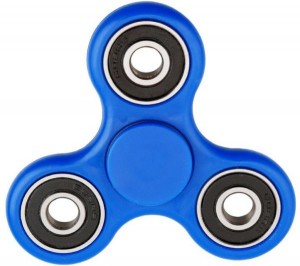If you’ve been anywhere near a school playground recently, you’ll have seen kids playing with what look like mini-propellers. Fidget spinners are the latest, greatest craze and are (a) entertaining and calming or (b) distracting and annoying, depending which side of the teacher’s desk you’re sitting.
Plenty of press coverage has centred on American Catherine Hettinger who has been cited as the fidget spinner’s inventor, focusing on how she has seen not a penny from the phenomenal worldwide success of this toy. 
Such stories seem to take the line that the patent system is inherently rigged against the little inventor who will inevitably be steamrollered by big business and vested interests. “Honest, real people” versus “wicked, global elite” is a popular narrative at the moment, but, in respect of this story at least, BrandSoup is prepared to call BS!
For a start, Ms Hettinger’s invention (as disclosed in US patent #5591062) was a sort of mini-Frisbee, with no bearings or moving parts.
A patent covers what it covers – no more, no less. Obviously, there can be arguments as to the exact scope but the fact remains that if another inventor can devise a way of “designing around” your idea, that’s fair game. And even clever lawyers like BrandSoup would have difficulty asserting that a patent for a single-piece moulded plastic disc should also encompass a multi-component device with bearings and blades.
A patent is effectively a bargain between an inventor and the state – in return for disclosing details of their invention (and thereby adding to the sum total of human knowledge), the inventor will be granted a monopoly over that invention. This monopoly can last a maximum of 20 years but has to be actively maintained during its lifetime, including by payment of renewal fees.
Only a tiny percentage of patented inventions make any money, and most patents are allowed to lapse early on grounds of cost. Ms Hettinger paid up for the first eight years, but then had to call it a day. 
So, far from being a hard luck story and evidence that the patent system is broken, fidget spinners seem to provide clear proof that the system is working how it should. Ms Hettinger had her moment of inspiration and was given the exclusive opportunity to profit from it.
Then someone else came along, innovated further, and likewise had the chance to reap the rewards of their own creativity. The fact that one succeeded while the other failed does not demonstrate an inbuilt flaw in the system, but reflects the hard truth that some people will always be better placed to make money than others.
That’s not to say that small inventors don’t suffer a disadvantage when compared to multinationals. And it’s certainly true that patents (which can take years to obtain and years further to turn a profit) can be an imperfect solution to a fast-moving industry where profit relies on being able to tool up, manufacture and distribute before demand evaporates and everyone’s moved on to the next big thing.
Ms Hettinger is reported to be crowdfunding a relaunch of her “classic” spinner on the back of her current limelight, and BrandSoup wishes her well. We also hope that, next time, she might give due consideration to all the other wonderful forms of intellectual property protection at her disposal.
This is the first article in our monthly BrandSoup series - a hearty concoction of crunchy facts, delicious ideas and fresh opinions served up by Thrings intellectual property partner Graeme Fearon. We’ll be stirring the bowl of current affairs, and looking for tidbits of brand, intellectual property and technology news to savour and share. Spoons to the ready!






























